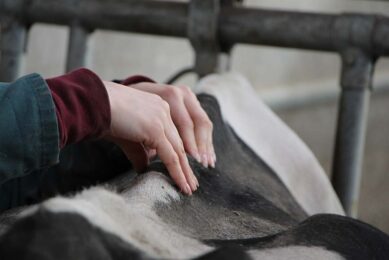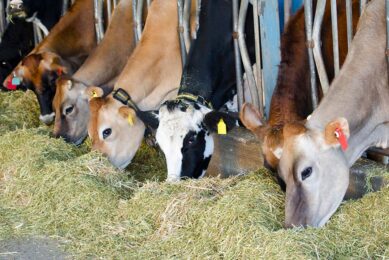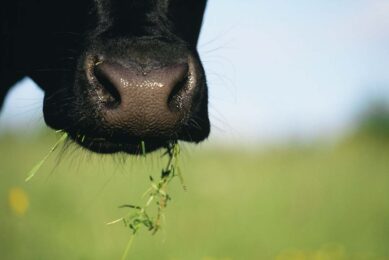Precision dairy farming: What does it mean today?
![[Photo: Henk Riswick]](https://www.dairyglobal.net/app/uploads/2021/09/001_221_rb-image-2780723-848x565.jpeg)
Researchers, academics and scientists are all excited by the possibilities of precision dairy farming but what does it really mean for a farmer today?
Precision dairy farming can be defined as the use of technologies to optimise the contribution from each animal. By taking a ‘per animal’ approach, the farmer can deliver better results in terms of higher quantities, better quality or more sustainable farming methods. As technological advances continue, farmers are now in a position to measure and analyse a vast array of their herd’s activities that just weren’t possible previously or were too time-consuming to be worth it. But with the ever-increasing amount of data available and solutions on sale, dairy farmers are facing the question of where to start. With the multitude of methods for measuring a farm and herd’s activity, it’s not an easy task knowing where to start for any farmer going down the road of precision dairy farming.
“Some areas are quite well developed and fine-tuned while others are kind of vague,” says Charlotte Hallén Sandgren, director of Dairy Development at DeLaval. “Some cost more and some less; some are more robust and others less reliable. It’s a jungle for farmers to figure out and a very thick jungle that is.” Hallén Sandgren does advise however that precision dairy farming doesn’t replace existing methods but should be treated as additional tools for the farmer. “The farmers that really understand their cows well are the ones that do best with precision farming. It gives them additional tools and they are interested in learning because they manage to introduce the new knowledge and use it in a beneficial way.”
What can be measured?
Today a farmer can monitor, among other things, the milk yield from every milking of every cow, heat, pregnancy, cow’s body condition score on a daily basis, the cow’s weight, respiration rate, chewing activity, rumen pH, water consumption, body temperature, feed intake, heart rate, methane emissions, lameness, lying and standing behaviour, sleep patterns and the list goes on and on.
But if a farmer is going to start investing in precision dairy farming methods, what should they do?
Start with milk recording and feeding
Recording the amount of milk daily from each of a farm’s cows is almost a must. There is a lot of software available from all suppliers in this area. “If you know how much milk each cow is delivering you can adjust their feed based on those results,” says Hallén Sandgren. “In small to mid-sized herds you can have individual feeding treatment that can result in significant savings. In short, automated milk recording pays for itself.” Add automated feeding to the list and there are very large time and money savings for the farm. By personalising the ratio of feed on individual cow or group level, you can improve the yield, increase the earnings and cut down on feed costs when needed. If you tie in automatic feeding with automatic milk yield measurements, you’re off to a very good start.
Heat detection for breeding
Profitability of a farm is normally tightly connected to the lactation interval of the herd. Breeding cows at the appropriate moment can have significant economic benefits for a farm. The question here then is to calculate the cost of the heat detection software and it’s accuracy versus the cost savings and earnings of the farm. There are quite a few different technologies out there so it’s important to choose the right one.
Mastitis detection
Every farmer knows about mastitis. The disease is common in herds and it negatively affects the animal’s ability to produce milk and that of course negatively affects the farm’s profitability. As a result, detecting mastitis early has obvious benefits from an animal welfare, environmental sustainability and profitability perspective, as unnecessary use of antibiotics can be avoided. There are various cell counters on the market that can monitor the somatic cell count and give farmers a daily update so that they can react in time. These counters are well established and usually quite accurate. DeLaval, for example, is currently offering an online cell counter that works in tandem with it’s robotic milking system DeLaval VMS™ and measures the somatic cell count with an optional frequency of every cow during a milking session.
After that, there is a large list of possible technologies and their benefits will depend on a farm’s situation. “Lameness is important for farmers,” says Hallén Sandgren “but it’s not always easy to get them to buy a system, so there’s more work to do there.”
Tomorrow’s solutions
“In the future, we will see companies like DeLaval integrate more data from various different systems into one single piece of software. We do this today with Herd Navigator, for instance. Herd Navigator is an advanced milk analysis tool. An extension to your herd management system, it detects the handful of cows which really need your attention. We’re creating a situation where the farmer doesn’t have to do the analysis and interpretation but can get solid recommendations to assist her or him with running their farm,” says Hallén Sandgren.
One area where Hallén Sandgren believes significant progress can be made is in measuring feed consumption for each
individual cow, as feed efficiency is key to a profitable production. “We still don’t know what every cow is eating and how much” says Hallén Sandgren. “From feed stations, we can get a lot of information and if we can tie that into information from regular body condition scoring as well as detection of the beta hydroxybutyrate (BHBA) then we can really make progress here. You can get this from our DeLaval BCS and DeLaval Herd Navigator™ today for example (detect the BHBA molecule) but if we can combine all of that information, then we get a very good picture as to the total feed intake of every individual cow and this can lead to significant improvements in detecting cows that need attention but also provide every cow with the right feed at the right time.” In the coming years, we are likely to see additional technologies and improved versions of current technologies so precision dairy farming will undoubtedly become a larger part of every farm’s working practices. One of the opportunities is to actually more intelligently combine the data already collected by our systems and create integrated systems predicting the cows that need to be taken care of.
Join 13,000+ subscribers
Subscribe to our newsletter to stay updated about all the need-to-know content in the dairy sector, two times a week.










